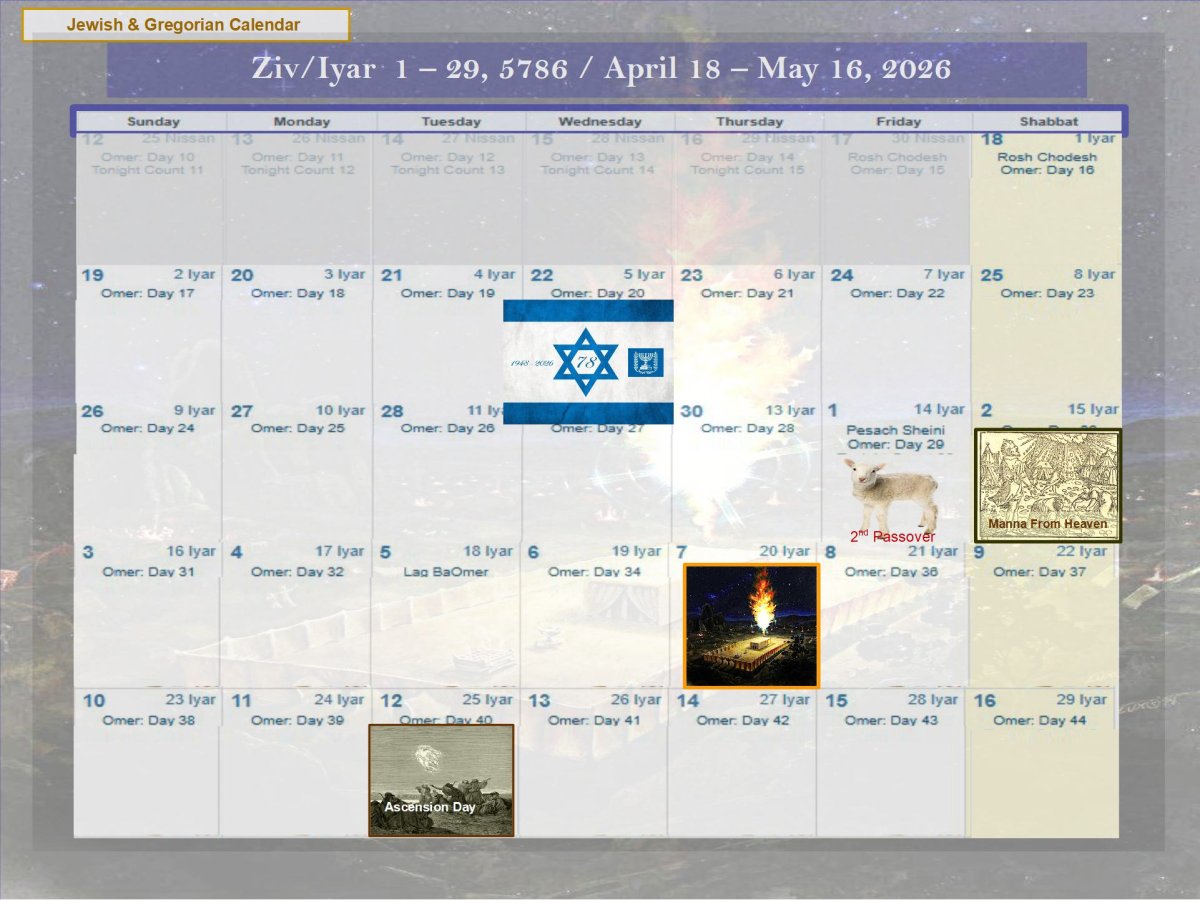The Month of Ziv ~ Iyar

The Month of Ziv ~ IyarBrightness
The biblical name for the second month is Ziv [Zif]. The name Iyar was adopted during the Babylonian exile. Associated with the spring season, it is a time of renewal and growth, which reflects its meaning of "brightness" or "splendor."
“So then after the LORD had spoken unto them, He was received up into heaven, and sat on the right hand of God.” ~ Mark 16:19
Of NOTE: When the Children of Israel departed, there was a certain order for each tribe. They did not leave as an unorganized mass of people.
- Iyar ~
- "And it came to pass in the four hundred and eightieth year after the children of Israel were come out of the land of Egypt, in the fourth year of Solomon's reign over Israel, in the month Zif [Iyar], which is the second month, that he began to build the house of the LORD." ~ 1 Kings 6:1
- In the fourth year was the foundation of the house of the LORD laid, in the month Zif: ~ 1 Kings 6:37 [4]
- 5 Iyar In 1948 Israel was reborn as a nation on 5 Iyar which landed on May 15 on the Gregorian calendar that year. This year Israel celebrates 77 years in its reestablishment since AD70 when most (not all) of the Jews as well as many Christians were driven out by the Romans.
- 10 Iyar (circa 2870/2871 BC) ~ Death of Eli the High Priest and his two sons.[2]
- 14 Iyar ~ "The “Second Passover” was Celebrated on 14 Iyar In Temple times, the Second Passover (Pesach Sheni) was observed by one who could not—by virtue of being impure or in a distant place—bring the Paschal offering during Passover. He was given a second chance to eat the sacrifice a month later on the night subsequent to 14 Iyar.11" ~ [1]
- 15 Ziv ~ Manna (bread) falls from heaven 30 days after exodus from Egypt. [5]
Researching in an effort to parse out the date of Noah's flood, there are four different dates to consider regarding Genesis 7:11:
Septuagint: In the six hundredth year of the life of Noe, in the second month, on the twenty-seventh day of the month, on this day all the fountains of the abyss were broken up, and the flood-gates of heaven were opened.
King James Version: In the six hundredth year of Noah's life, in the second month, the seventeenth day of the month, the same day were all the fountains of the great deep broken up, and the windows of heaven were opened.
Septuagint: In the six hundredth year of the life of Noe, in the second month, on the twenty-seventh day of the month, on this day all the fountains of the abyss were broken up, and the flood-gates of heaven were opened.
King James Version: In the six hundredth year of Noah's life, in the second month, the seventeenth day of the month, the same day were all the fountains of the great deep broken up, and the windows of heaven were opened.
Identifying the month also falls into two categories.
1) The New Year for Years beginning 1 Tishrei brings us to Bul/Cheshvon as the 2nd month and would be counting from the beginning of creation. It would have been the calendar at the time of Noah.
2) The New Year for Kings & Festivals calendar beginning 1 Nisan brings us to Ziv/Iyar as the 2nd month. This calendar was initiated by the LORD God to Moses in Exodus 12. There are some who count the flood as having occurred in Ziv/Iyar though Bul/Cheshvon is the prominently recognized.
Only the LORD Jesus Christ and God the Father know the true month and day.
- 20 Iyar (1312 BCE) ~ The LORD God guides the Children of Israel as they departed their encampment near the Mt Sinai nearly a year after receiving the Law of Moses, the Torah. As they continued their journey the pillar of cloud rose for the first time from over the Tabernacle giving them a divine sign to resume their travels. This continued over the next 38 years until reaching east bank of the Jordan River just prior to entry into the Holy Land. [3]
- 25 Iyar Ascension Day ~ Jesus Christ ascended from earth to heaven 10 day before Pentecost having told the Apostles to wait in Jerusalem until they receive power from on high.
“So then after the LORD had spoken unto them, He was received up into heaven, and sat on the right hand of God.” ~ Mark 16:19
Of NOTE: When the Children of Israel departed, there was a certain order for each tribe. They did not leave as an unorganized mass of people.
Numbers 10:1-28 lays this out. It also includes the blowing of the horns; when to leave and when to gather. It is of consideration that when the LORD calls His children out of the world through the raptures that this too will be done in an orderly way.
As posted elsewhere on this site Rapture Harvests ; the Apostle Paul makes note of this:
As posted elsewhere on this site Rapture Harvests ; the Apostle Paul makes note of this:
“But every man in his own order [G5001]: Christ the firstfruits; afterward they that are Christ's at His coming.” ~ 1 Corinthians 15:23
The KJV translates Strong's G5001 in the following manner: order (1x). that which has been arranged, thing placed in order ~ a body of soldiers, a corps ~ band, troop, class Greek Word: τάγμα tágma, tag'-mah; from G5021; something orderly in arrangement (a troop), i.e. (figuratively) a series or succession:—order.
